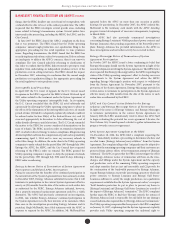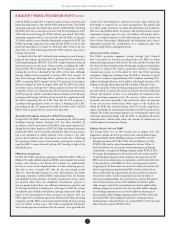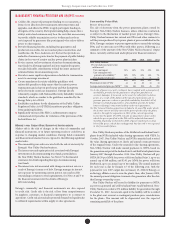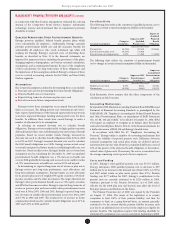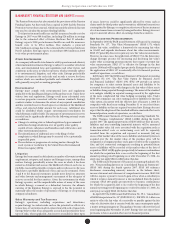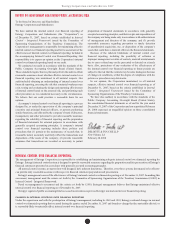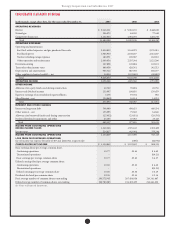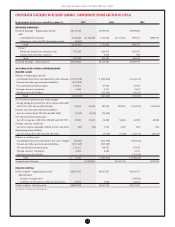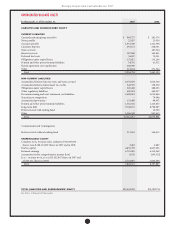Entergy 2007 Annual Report Download - page 51
Download and view the complete annual report
Please find page 51 of the 2007 Entergy annual report below. You can navigate through the pages in the report by either clicking on the pages listed below, or by using the keyword search tool below to find specific information within the annual report.
49
Entergy Corporation and Subsidiaries 2007
estimate of decommissioning costs will aect net income, only to
the extent that the estimate of any reduction in the liability exceeds
the amount of the undepreciated asset retirement cost at the date
of the revision, for unregulated portions of Entergy’s business.
Any increases in the liability recorded due to such changes are
capitalized and depreciated over the asset’s remaining economic
life in accordance with SFAS 143.
n SPENT FUEL DISPOSAL – Federal regulations require the
Department of Energy (DOE) to provide a permanent repository
for the storage of spent nuclear fuel, and legislation has been
passed by Congress to develop this repository at Yucca Mountain,
Nevada. Until this site is available, however, nuclear plant operators
must provide for interim spent fuel storage on the nuclear plant
site, which can require the construction and maintenance of
dry cask storage sites or other facilities. e costs of developing
and maintaining these facilities can have a signicant eect (as
much as 16% of estimated decommissioning costs). Entergy’s
decommissioning studies may include cost estimates for spent fuel
storage. However, these estimates could change in the future based
on the timing of the opening of the Yucca Mountain facility, the
schedule for shipments to that facility when it is opened, or other
factors. Entergy is pursuing damages claims against the DOE for
its failure to pick up spent fuel timely.
n TECHNOLOGY AND REGULATION – To date, there is
limited practical experience in the United States with actual
decommissioning of large nuclear facilities. As experience is
gained and technology changes, cost estimates could also change.
If regulations regarding nuclear decommissioning were to change,
this could have a potentially signicant eect on cost estimates.
e eect of these potential changes is not presently determinable.
Entergy’s decommissioning cost studies assume current
technologies and regulations.
In the fourth quarter of 2007, Entergy’s Non-Utility Nuclear business
recorded an increase of $100 million in decommissioning liabilities for
certain of its plants as a result of revised decommissioning cost studies.
e revised estimates resulted in the recognition of a $100 million asset
retirement obligation asset that will be depreciated over the remaining
life of the units.
In the third quarter of 2006, Entergy’s Non-Utility Nuclear business
recorded a reduction of $27 million in decommissioning liability for a
plant as a result of a revised decommissioning cost study and changes
in assumptions regarding the timing of when decommissioning of
the plant will begin. e revised estimate resulted in miscellaneous
income of $27 million ($16.6 million net-of-tax), reecting the excess
of the reduction in the liability over the amount of undepreciated asset
retirement cost recorded at the time of adoption of SFAS 143.
In the rst quarter of 2005, Entergy’s Non-Utility Nuclear business
recorded a reduction of $26.0 million in its decommissioning cost
liability in conjunction with a new decommissioning cost study as a
result of revised decommissioning costs and changes in assumptions
regarding the timing of the decommissioning of a plant. e revised
estimate resulted in miscellaneous income of $26.0 million ($15.8
million net-of-tax), reecting the excess of the reduction in the liability
over the amount of undepreciated assets retirement cost recorded at
the time of adoption of SFAS 143.
UN B I L L E D RE V E N U E
As discussed in Note 1 to the nancial statements, Entergy records an
estimate of the revenues earned for energy delivered since the latest
customer billing. Each month the estimated unbilled revenue amounts
are recorded as revenue and a receivable, and the prior month’s
estimate is reversed. The difference between the estimate of the
unbilled receivable at the beginning of the period and the end of the
period is the amount of unbilled revenue recognized during the period.
The estimate recorded is primarily based upon an estimate of customer
usage during the unbilled period and the billed price to customers in
that month, including fuel price. Therefore, revenue recognized may
be affected by the estimated price and usage at the beginning and
end of each period and fuel price uctuations, in addition to changes
in certain components of the calculation. Eective January 1, 2006,
Entergy Louisiana and Entergy Gulf States Louisiana reclassied the
fuel component of unbilled accounts receivable to deferred fuel and
will no longer include the fuel component in the unbilled calculation,
which is in accordance with regulatory treatment.
IM P A I R M E N T O F LONG-L I V E D AS S E T S
Entergy has signicant investments in long-lived assets in all of its
segments, and Entergy evaluates these assets against the market
economics and under the accounting rules for impairment whenever
there are indications that impairments may exist. is evaluation
involves a signicant degree of estimation and uncertainty, and these
estimates are particularly important in Entergy’s Utility business and
the non-nuclear wholesale assets business. In the Utility business,
portions of River Bend and Grand Gulf are not included in rate base,
which could reduce the revenue that would otherwise be recovered
for the applicable portions of those units’ generation. In the non-
nuclear wholesale assets business, Entergy’s investments in merchant
generation assets are subject to impairment if adverse market
conditions arise.
In order to determine if Entergy should recognize an impairment
of a long-lived asset that is to be held and used, accounting standards
require that the sum of the expected undiscounted future cash
ows from the asset be compared to the asset’s carrying value. If the
expected undiscounted future cash ows exceed the carrying value, no
impairment is recorded; if such cash ows are less than the carrying
value, Entergy is required to record an impairment charge to write the
asset down to its fair value. If an asset is held for sale, an impairment is
required to be recognized if the fair value (less costs to sell) of the asset
is less than its carrying value.
ese estimates are based on a number of key assumptions,
including:
n FUTURE POWER AND FUEL PRICES – Electricity and gas prices
have been very volatile in recent years, and this volatility is
expected to continue. is volatility necessarily increases the
imprecision inherent in the long-term forecasts of commodity
prices that are a key determinant of estimated future cash ows.
n MARKET VALUE OF GENERATION ASSETS – Valuing assets held
for sale requires estimating the current market value of generation
assets. While market transactions provide evidence for this
valuation, the market for such assets is volatile and the value of
individual assets is impacted by factors unique to those assets.
n FUTURE OPERATING COSTS – Entergy assumes relatively minor
annual increases in operating costs. Technological or regulatory
changes that have a signicant impact on operations could cause a
signicant change in these assumptions.
In the fourth quarter of 2005, Entergy recorded a charge of $39.8
million ($25.8 million net-of-tax) as a result of the impairment of the
Competitive Retail Services business’ information technology systems.
Entergy decided to divest the retail electric portion of the Competitive
Retail Services business operating in the ERCOT region of Texas and,
Management’s Financial Discussion and Analysis conti nued







